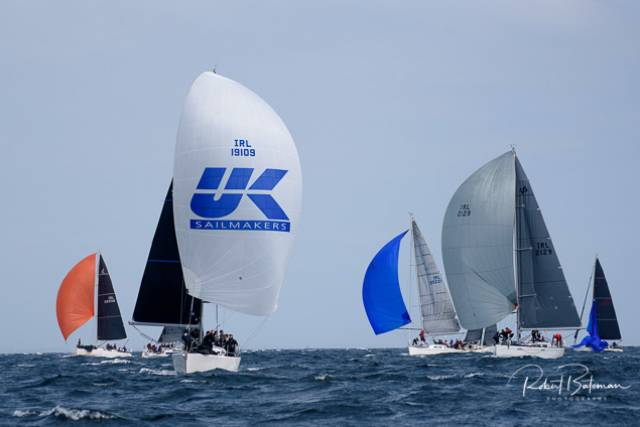Barry Hayes of UK Sailmakers Ireland goes through the options for racing boats to go Symmetrical or Asymmetrical with their spinnakers. Barry sailed aboard George Sisk's XP44 WOW from Royal Irish Yacht Club at this year's Sovereigns Cup, where WOW won all races in the Coastal Division. UK Sailmaker's boats also won Class One, Whitesail One and the 1720 Sportsboat divisions at the Cup.
In the past 10 or 15 years, spinnaker options have increased considerably. Prior to that, it was fairly straightforward. You bought a light air symmetric spinnaker, a heavy air version of the same and maybe a reaching spinnaker.
In recent years, however, Asymmetric spinnakers have become a lot more efficient and some yacht builders, particularly J boats, feature them almost exclusively on their models. Below we are going to do an analysis of which option is better for racing inshore/offshore.
First the pros and cons of each option:
Asymmetric Spinnakers
Pros
- Easier trimmed and handled
- IRC rating allows larger asymmetric spinnakers for the same rating, relative to symmetrics
- Very efficient when reaching as shape allows better exhaust of the air.
- Code 0 models (very flat Asymmetric) is a must for offshore boats
Cons
- Needs a sprit or prodder to set them properly away from the bow.
- They don’t run as deep and efficiently as Symmetric spinnakers.
- In Heavy air, they sometimes can wrap around the forestay when gybing
- Time is always lost gybing, compared to boats with poles
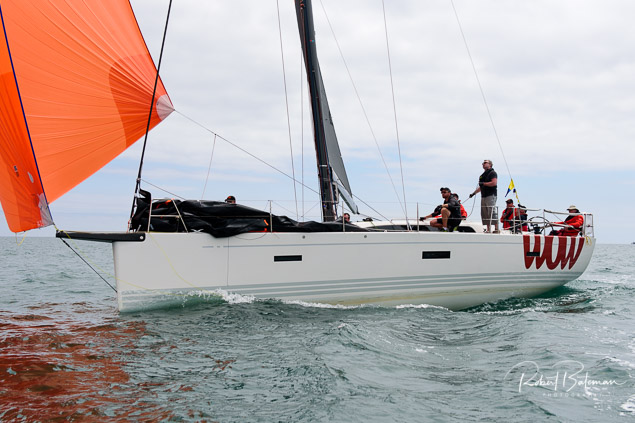 George Sisk's XP 44 WOW from the Royal Irish, with her Matrix A2 Asymmetrical spinnaker and Uni Titanium main Photo: Bob Bateman
George Sisk's XP 44 WOW from the Royal Irish, with her Matrix A2 Asymmetrical spinnaker and Uni Titanium main Photo: Bob Bateman
Symmetric Spinnakers
Pros
- Once above 12 knots, they are very efficient running with pole pulled back.
- Tactically, they offer a better crew, greater options downwind.
- Very little time lost while gybing.
Cons
- Expensive on IRC rating—On a J109 it costs about 7 points if you want the same sized spinnaker
- Not as efficient when reaching due to shape
- much more difficult to hoist and trim properly
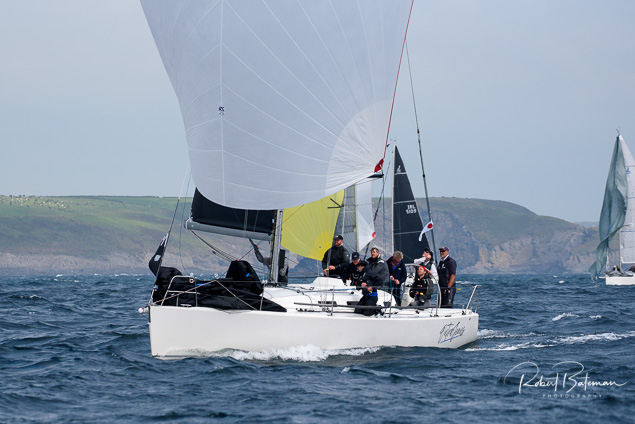 The J109 Outrageous - the spinnaker pole is fully back in 18 knots Photo: Bob Bateman
The J109 Outrageous - the spinnaker pole is fully back in 18 knots Photo: Bob Bateman
At UK Sailmakers Ireland, we had a J109 client this year that opted to go for Symmetric spinnakers on a boat that is designed for A sails. Before we went down this route, we did extensive testing and trial certs to see what the benefits would be. The bottom line is that there is no perfect answer. Were you able to have two IRC certs (one Symmetric, one Asymmetric), and be able to select which one, each race, then you would have both set-ups.
However IRC does not allow this and most regattas insist you don’t change your cert in the last 10 days before a regatta, as long-range weather forecast details may play a part in your decision.
A number of other sprit boats have moved to Symmetric this year, including Anthony O'Leary’s converted 1720, Antix Beag from Royal Cork and Stephen Quinn’s J97 Lambay Rules from Howth.
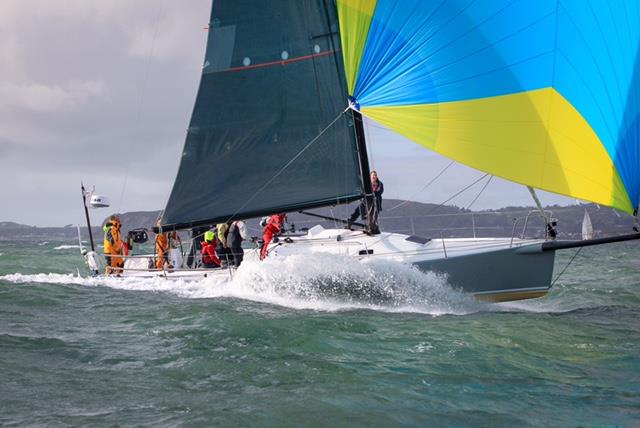 Andrew Hall's Jackknife, winning in ISORA with his UK Sails Matrix A4 Asymmetric spinnakers and Uni Titanium Main
Andrew Hall's Jackknife, winning in ISORA with his UK Sails Matrix A4 Asymmetric spinnakers and Uni Titanium Main
Bottom Line —A sails are generally more efficient on normal cruisers in less than 12 knots than symmetric spinnakers. Why?
Up to 12 knots, most symmetric boats struggle to get their spinnaker poles back that far, as the spinnaker will collapse. So an A2 Asymmetric boat will likely be able to run as deep as an S2 Symmetric boat, but the A2 Asymmetric usually will have a larger spinnaker area and a lower rating. IRC, it appears, penalises a boat with a pole by about seven points (on a J109), for the ability to be able to pull the pole back and go deep.
In light airs, if you can’t get the pole back, then you are at a disadvantage. Add to that, an Asymmetric sail is more efficient going at higher angles, than boats with symmetric spinnaker.
Bottom Line—Symmetric spinnakers are more efficient running in more than 14 knots. Why?
Once a symmetric boat can get its pole fully back, it can normally nearly run square, or maybe 10 degrees off square. A similar designed boat with an Asymmetric spinnaker will likely go the same speed, but be 10 degrees or more higher. When the two boats get to the bottom mark, the Symmetric boat has likely pulled out 30 to 60 seconds. Add to this, the symmetric boat can throw in gybes easily to stay in wind or get away from other boats' wind shadows, and the gain becomes even larger. If the wind gets up to 20 knots or more running, the symmetric boats have an even bigger advantage.
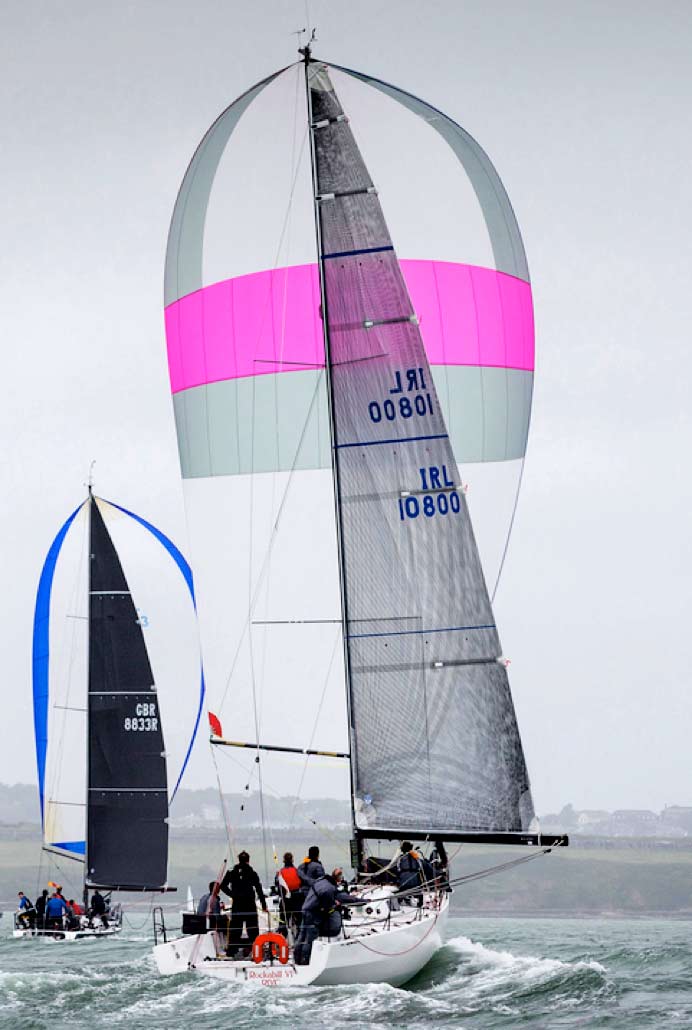 Paul O'Higgins's JPK 10.80 Rockabill VI from the Royal Irish, winner of this year's Dun Laoghaire to Dingle Race, running square with her UK sails Matrix symmetric spinnaker
Paul O'Higgins's JPK 10.80 Rockabill VI from the Royal Irish, winner of this year's Dun Laoghaire to Dingle Race, running square with her UK sails Matrix symmetric spinnaker
Bottom Line—Asymmetric boats are generally more efficient offshore and on Coastal racing.
This is because the two scenarios above relate to running square downwind, as you would have in Windward Leeward racing. On offshore and coastal races, often there is a lot of reaching and broad reaching. The A sail boats then have their rating advantage, and the efficiency of the A sail when reaching.
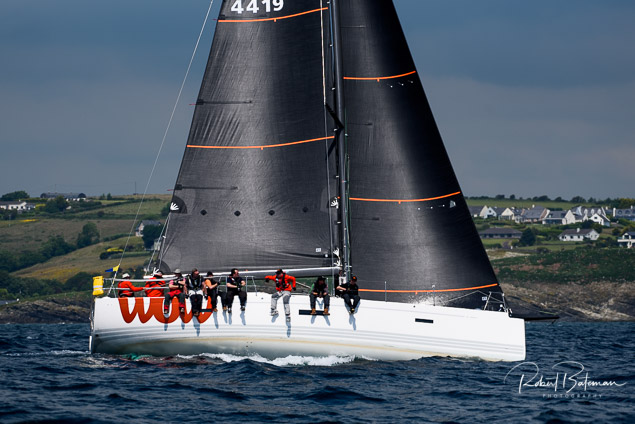 George Sisk's XP 44 Wow on the way to winning Sovereigns Cup—Coastal with his Uni Titanium sails
George Sisk's XP 44 Wow on the way to winning Sovereigns Cup—Coastal with his Uni Titanium sails
What are the crewing considerations?
Trimming a symmetric spinnaker is considerably more difficult to do well, than trimming an Asymmetric spinnaker. A symmetric spinnaker needs the sheet adjusted constantly, the guy adjusting the angle of the pole is constantly being adjusted, as is the pole height and the spinnaker tweaker.
On an Asymmetric sail, it is generally just the A sail sheet that is adjusted. You may move the tackline in and out a bit, but not that much. As a result, to get the best out of a symmetrical spinnaker, more good crew are needed to trim it well.
What about boats having both sail setups?
Any boat opting for a symmetric setup should also be planning to take some Asymmetric spinnakers as well. To do this efficiently, it needs a small sprit or prodder, to use with the A-sail for reaching conditions. The IRC rule allows a prodder (or sprit) on a symmetrically configured boat, as long as the prodder does not extend out further than the pole does.
However, the A sail size (SPA) on these A sails cannot be any bigger than the largest symmetric spinnaker. So in the case of our J109 this year which went Symmetric, we opted for a 102 sq. metre Symmetric spinnaker, which is six sq metres smaller than the Class A sail size. This saved us two points off the rating, so the seven-point hit for the pole was lessened to five points overall. The new A sails added, to cover her reaching requirements were a code 0 for light air reaching and an AO, for light air running. The AO can be used off the prodder, or can also be transferred to a lowered pole, with the pole being pulled back to allow further depth.
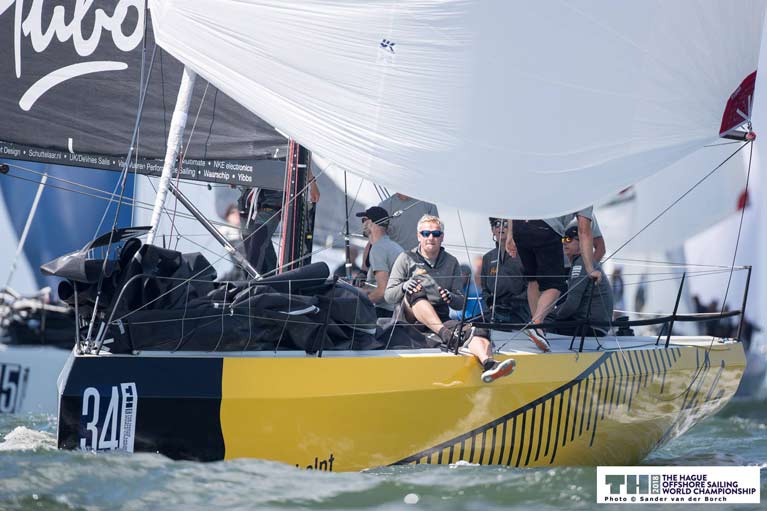 In these photos you can see the Warship 36 using both the pole (above) and Asym set up (below) with her UK Sails A0 and S2 spinnaker
In these photos you can see the Warship 36 using both the pole (above) and Asym set up (below) with her UK Sails A0 and S2 spinnaker
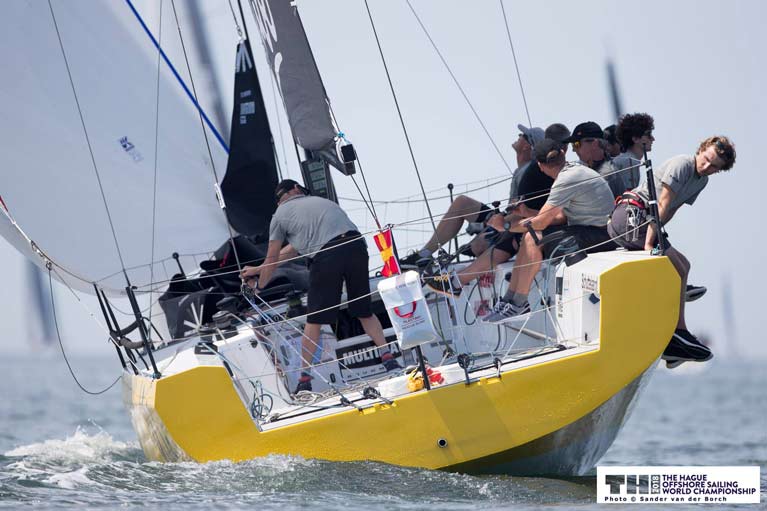
Cost Considerations
For an existing Symmetrical boat, changing to No pole and just using A sails would require,
- A sprit
- New Spinnaker specific A sail sheets
- New Asymmetrical spinnakers
- A tack line to attach the A sail to the Sprit
For an existing A sail boat, to go to Symmetrical configuration requires,
- A pole
- A track on the mast
- additional Blocks etc. to cover sheets and guys and pole downhaul
- Symmetrical spinnakers and perhaps some A sails as well.
For someone ordering a new boat—Best to try and incorporate both options from day one, even if only opting for one setup.
So –Which option to go for?
As I said in my opening paragraph, there is no perfect choice, but here is a quick plan.
- For Light planing boats - Go A sail, as you will always be going higher angles
- For short-handed - A sail is a lot easier for Handling
- For Offshore/Coastal - A sail will likely be best, as more reaching than running
- For Inshore, in lighter air areas, go A-sail
- For Inshore in stronger wind areas - Go Symmetric.
- For Inshore in mixed conditions -Either works, but Symmetric with a good crew might just have the edge if you also have some good A sail options as well.
UK Sailmakers Ireland Have a highly experienced and Knowledgeable team to assist you in any sail choice or query you may have. Please feel free to contact any of the below to discuss your needs.



























